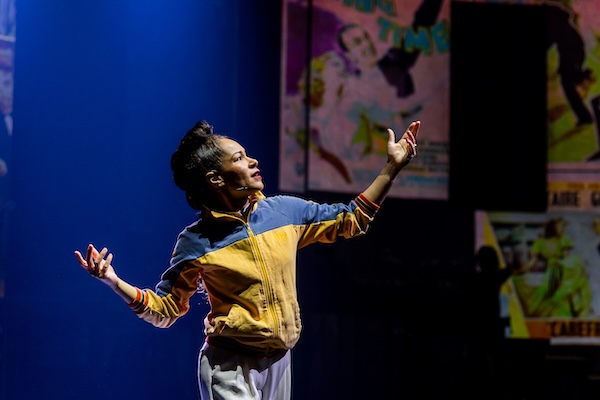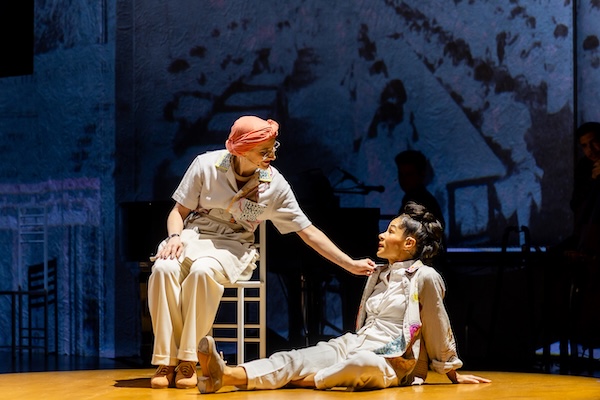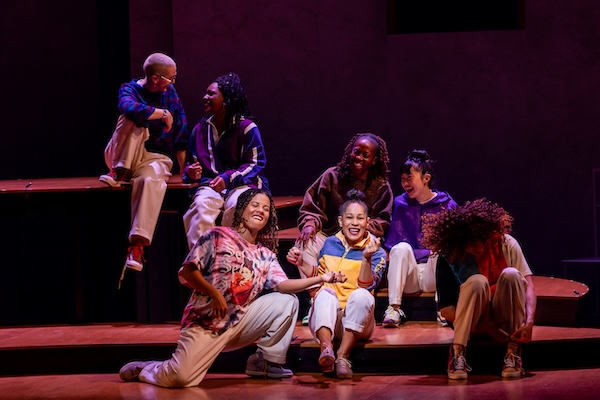Dance Review: “Diary of a Tap Dancer” — Say Their Names
By Debra Cash
Is it possible to reclaim a marginalized legacy? And how do you step up to take a seat at the table when your history has been neglected and forgotten?
Diary of a Tap Dancer written and choreographed by Ayodele Casel, directed by Torya Beard. Scenic design by Tatiana Kahvegian, costume design by Camilla Dey, lighting design by Brandon Stirling Baker, sound design by Sharath Patel, projection design by Katherine Freer. Produced at American Repertory Theater, Cambridge, through January 4, 2025.
In 2020, right before the pandemic shut us all down, I attended Ayodele Casel’s artist’s talk at the Radcliffe Institute. Taps on her feet, fierce affirmation in her voice, she invoked tap’s forgotten Black women of the 1930s-50s, the dancers of the Apollo Theater chorus line, the headliners of Black vaudeville, the heroines who upstaged white dancers in Hollywood production numbers and were punished by having their performances left on the cutting room floor.
A.R.T.’s producers saw the presentation too. They commissioned Diary of a Tap Dancer, a full-length ensemble work directed by Casel’s wife, Torya Beard. Based on A.R.T.’s production track record, I presume a Broadway run is in the works.
It’s almost, but not quite ready.

Ayodele Casel in Diary of a Tap Dancer. Photo: Nile Scott Studios and Maggie Hall
Diary of a Tap Dancer takes some of its opening material from a schoolgirl’s homesick notes on lined notebook paper — Ayodele was sent from the Bronx to live with her maternal grandparents in Puerto Rico where a one-year sojourn turned into six — but over the course of the show, it expands beyond her personal experience. Diary of a Tap Dancer poses two key questions. Is it possible to reclaim a marginalized legacy? And how do you step up to take a seat at the table when your history has been neglected and forgotten?
Act One tells the story of a headstrong, biracial kid — Casel was so apt to pick fights classmates nicknamed her Muhammed Ali — and the family she knew, didn’t know, and intuited. Her Puerto Rican mother, who watched Golden Age Hollywood movies with her daughter. Her Black Power father, a martial arts master (from whom, perhaps, Casel inherited her stamina and athleticism) who disappeared from her life for 17 years. Her beloved young uncle lost to drugs. Her taciturn grandfather, who worked cutting sugar cane, and affectionate grandmother, who stitched handkerchiefs for 25 cents a dozen. The scars of this period in her life are left unreflected on, as if Casel is afraid of lapsing into stereotypes. Yet by sketching these figures in her life in such generalized strokes, they remain a child’s simplifications.
After some old school South Bronx hip-hop (the dancers wear sneakers), Casel’s tap choreography and dancing for herself and her top-notch ensemble juxtaposes different rhythmic traditions — West African, bomba, plena, swing — accompanied by keen drummer Keisel Jimenez Levya with pianist Carlos Cippelletti and Raul Reyes Bueno on bass. Little clues pepper the choreography: a sand dance indicates her move to island climes, and I caught what looked like a Bill Robinson hornpipe quote. Most of Act One concerns the consistent disregard of those who should have appreciated and welcomed her, including the not exactly named but easily identifiable all-male crew of Savion Glover’s NYOT (Not Your Ordinary Tappers). The narrative arc is How She Got to Be the gifted, public person we are encountering.

Liberty Styles and Ayodele Casel in Diary of a Tap Dancer. Photo: Nile Scott Studios and Maggie Hall
Casel’s biography provides the facts, but dancing is the real story. Entering a tap class as a sophomore at NYU, she found an art form that could contain, and challenge, her restless, inventive temperament. Casel is funny pretending not to know how to dance — her off-pitch singing at her first professional audition is hilarious — but by Act Two she and her seven dancers (Naomi Funaki, Afra Hines, Quynn L. Johnson, Funmi Sofola, Liberty Styles, Annaliese Wilbur, and Ki’Leigh Williams) are ready to unleash their virtuosity. Documents legally restricting the behavior of enslaved people are projected on the back wall in a sooty blue light. The ensemble erupts into a furious rhythmic march. An uncanny variety act looks like something Bob Fosse might have choreographed if his dancers had exchanged their bowlers for white top hats.
Casel finds that her legacy is distorted not just by racism but by even-less acknowledged misogyny. Learning about Black women in tap, she realizes how few of them are as well known as their male counterparts. She becomes a dogged researcher, reading a Village Voice article by Itabari Njeri, a dissertation by Cheryl Willis, seeking out rare film clips, asking impertinent questions of the aging (male) tap masters, and finally journeying to Canada to sit with then 84-year-old Jeni Le Gon, “the sepia Cinderella of tap,” who told Casel that she thought the world had forgotten all about her.
Casel gets choked up in this part of Diary, and it doesn’t seem like she is acting. She notes, and expresses appreciation, that in the 1970s and ’80s, a group of white women (and she should say their names, too: they included Avra Petrides, Marda Kirn, Sali Ann Kriegsman, and Jane Goldberg) created festivals that brought aging male tap masters like Honi Coles, John Bubbles, and Jimmy Slyde out of retirement and back into a well-deserved spotlight. But with the notable exception of the great Dianne Walker, Black women in tap were rarely invited.

The cast of Diary of a Tap Dancer. Photo: Nile Scott Studios and Maggie Hall
She’s right, as much as it hurts to admit it. It was an injustice, and it shouldn’t have happened.
If Ayodele Casel does anything in her life — that is, besides dance and choreograph with force and clarity — it is to rectify that omission to the best of her ability.
She will share what she knows.
She will say their names.
In the final, emotional moments of Diary of a Tap Dancer, Katherine Freer’s projections on the back wall list the names of dozens of women tap dancers of every background and identity, from women whose achievement is preserved only in rare film clips to those who are dancing today.
“Everyone who sees me will see them,” Ayodele Casel declares.
Knowing some of the women on that list, I cried.
Debra Cash is a founding Contributing Writer to the Arts Fuse and a member of its Board.
Tagged: "Diary of a Tap Dancer", Afra Hines, Annaliese Wilbur, Ayodele Casel, Funmi Sofola, Ki’Leigh William, Liberty Styles, Naomi Funaki, Quynn L. Johnson, Tap-dance, tap-dancing

WOW! How can I see this amazing work and share it with my tap students?
Oh Ashley, I’m sorry, the show closed Jan 4. But I’m willing to bet it will reopen on tour and/or in New York. Watch the embedded video of her Radcliffe show with your students. You can write to her https://www.ayodelecasel.com/contact and she may have some details of upcoming performances. One hint from a sometimes dance history professor: if you haven’t shown your students the Nicholas Brothers in Stormy Weather, do it pronto. Luckily, YouTube has their most famous production number. https://www.youtube.com/watch?v=uSJeVhTHzSA